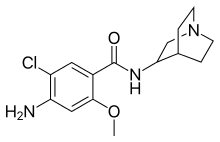Zacopride
Zacopride is a potent antagonist at the 5-HT3 receptor[1] and an agonist at the 5-HT4 receptor.[2] It has anxiolytic[3] and nootropic effects in animal models,[4] with the (R)-(+)-enantiomer being the more active form.[5] It also has antiemetic[6] and pro-respiratory effects, both reducing sleep apnea[7] and reversing opioid-induced respiratory depression in animal studies.[8] Early animal trials have also revealed that administration of zacopride can reduce preference for and consumption of ethanol.[9]
 | |
| Clinical data | |
|---|---|
| ATC code |
|
| Identifiers | |
| |
| CAS Number | |
| PubChem CID | |
| IUPHAR/BPS | |
| ChemSpider | |
| UNII | |
| ChEMBL | |
| CompTox Dashboard (EPA) | |
| Chemical and physical data | |
| Formula | C15H20ClN3O2 |
| Molar mass | 309.79 g·mol−1 |
| 3D model (JSmol) | |
| |
| |
| | |
Zacopride was found to significantly increase aldosterone levels in human subjects for 180 minutes at a dose of 400 micrograms. It is thought to do this by stimulating the 5-HT4 receptors on the adrenal glands. Zacopride also stimulated aldosterone secretion when applied to human adrenal glands in vitro. No significant changes were observed in renin, ACTH, or cortisol levels.[2]
Zacopride has been tested in clinical trials for the treatment of schizophrenia, but was found unsuccessful.[10]
References
- Smith WW, Sancilio LF, Owera-Atepo JB, Naylor RJ, Lambert L (April 1988). "Zacopride, a potent 5-HT3 antagonist". The Journal of Pharmacy and Pharmacology. 40 (4): 301–2. doi:10.1111/j.2042-7158.1988.tb05253.x. PMID 2900319.
- Lefebvre H, Contesse V, Delarue C, Soubrane C, Legrand A, Kuhn JM, et al. (December 1993). "Effect of the serotonin-4 receptor agonist zacopride on aldosterone secretion from the human adrenal cortex: in vivo and in vitro studies". The Journal of Clinical Endocrinology and Metabolism. 77 (6): 1662–6. doi:10.1210/jc.77.6.1662. PMID 8263156.
- Costall B, Domeney AM, Gerrard PA, Kelly ME, Naylor RJ (April 1988). "Zacopride: anxiolytic profile in rodent and primate models of anxiety". The Journal of Pharmacy and Pharmacology. 40 (4): 302–5. doi:10.1111/j.2042-7158.1988.tb05254.x. PMID 2900320.
- Fontana DJ, Daniels SE, Eglen RM, Wong EH (March 1996). "Stereoselective effects of (R)- and (S)-zacopride on cognitive performance in a spatial navigation task in rats". Neuropharmacology. 35 (3): 321–7. doi:10.1016/0028-3908(96)00191-8. PMID 8783207.
- Young R, Johnson DN (August 1991). "Anxiolytic-like activity of R(+)- and S(-)-zacopride in mice". European Journal of Pharmacology. 201 (2–3): 151–5. doi:10.1016/0014-2999(91)90338-Q. PMID 1686755.
- Yamakuni H, Nakayama H, Matsui S, Imazumi K, Matsuo M, Mutoh S (May 2006). "Inhibitory effect of zacopride on Cisplatin-induced delayed emesis in ferrets". Journal of Pharmacological Sciences. 101 (1): 99–102. doi:10.1254/jphs.SCJ05007X. PMID 16651699.
- Carley DW, Depoortere H, Radulovacki M (2001). "R-zacopride, a 5-HT3 antagonist/5-HT4 agonist, reduces sleep apneas in rats". Pharmacology, Biochemistry, and Behavior. 69 (1–2): 283–9. doi:10.1016/S0091-3057(01)00535-4. PMID 11420096.
- Meyer LC, Fuller A, Mitchell D (February 2006). "Zacopride and 8-OH-DPAT reverse opioid-induced respiratory depression and hypoxia but not catatonic immobilization in goats". American Journal of Physiology. Regulatory, Integrative and Comparative Physiology. 290 (2): R405-13. doi:10.1152/ajpregu.00440.2005. PMID 16166206.
- Knapp DJ, Pohorecky LA (April 1992). "Zacopride, a 5-HT3 receptor antagonist, reduces voluntary ethanol consumption in rats". Pharmacology, Biochemistry, and Behavior. 41 (4): 847–50. doi:10.1016/0091-3057(92)90237-A. PMID 1594653.
- Newcomer JW, Faustman WO, Zipursky RB, Csernansky JG (September 1992). "Zacopride in schizophrenia: a single-blind serotonin type 3 antagonist trial". Archives of General Psychiatry. 49 (9): 751–2. doi:10.1001/archpsyc.1992.01820090079013. PMID 1514881.